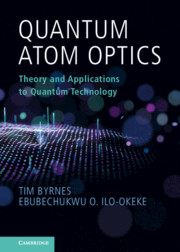Book contents
- Frontmatter
- Dedication
- Contents
- Foreword
- Preface
- 1 Quantum Many-Body Systems
- 2 Bose–Einstein Condensation
- 3 The Order Parameter and Gross–Pitaevskii Equation
- 4 Spin Dynamics of Atoms
- 5 Spinor Bose–Einstein Condensates
- 6 Diffraction of Atoms Using Standing Wave Light
- 7 Atom Interferometry
- 8 Atom Interferometry Beyond the Standard Quantum Limit
- 9 Quantum Simulation
- 10 Entanglement Between Atom Ensembles
- 11 Quantum Information Processing with Atomic Ensembles
- References
- Index
10 - Entanglement Between Atom Ensembles
Published online by Cambridge University Press: 23 July 2021
- Frontmatter
- Dedication
- Contents
- Foreword
- Preface
- 1 Quantum Many-Body Systems
- 2 Bose–Einstein Condensation
- 3 The Order Parameter and Gross–Pitaevskii Equation
- 4 Spin Dynamics of Atoms
- 5 Spinor Bose–Einstein Condensates
- 6 Diffraction of Atoms Using Standing Wave Light
- 7 Atom Interferometry
- 8 Atom Interferometry Beyond the Standard Quantum Limit
- 9 Quantum Simulation
- 10 Entanglement Between Atom Ensembles
- 11 Quantum Information Processing with Atomic Ensembles
- References
- Index
Summary
This chapter introduces the notion of entanglement, methods of detection, and various types of two atomic ensemble entangled states. Bipartite The bipartite system constitutes is the simplest and most straightforward way of understanding entanglement, where there is a well-developed theory of detecting and quantifying it. We discuss how von Neumann entropy and negativity are two simple and powerful quantifiers of entanglement in pure and mixed systems, respectively. In the absence of a way to topographically reconstruct the density matrix, other correlation-based entanglement criteria are important practically, since they only involve the measurement of some key correlations. Various approaches to this are introduced, such as the Duan--Giedke--Cirac--Zoller criterion, Hillery--Zubairy criteria, entanglement witness approaches, and covariance matrices. Finally, two types of squeezed states for two atomic ensembles are introduced, : namely the one-axis two-spin and two-axis two-spin squeezed states are introduced.
Keywords
- Type
- Chapter
- Information
- Quantum Atom OpticsTheory and Applications to Quantum Technology, pp. 175 - 198Publisher: Cambridge University PressPrint publication year: 2021



